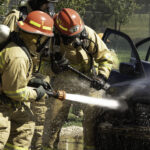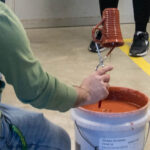Thanksgiving is the ultimate American food holiday. Mashed potatoes, stuffing, green bean casserole, mac and cheese and pumpkin pie can be found on millions of tables across the country on Thanksgiving day but in this tour de force of festive fare, turkey is king.
Roasting a large bird on which the entire Thanksgiving experience hinges can be an anxiety-inducing experience, but Kirkwood culinary instructor Chef Mike Barshis offered these tips on how to give the star of the holiday meal the treatment it deserves.
First, start with a high-quality bird. Frozen turkeys are typically fine, but Chef Barshis recommends spending a little extra, if possible, for an organic bird or one sourced from a family farm.
These turkeys tend to receive more involved care and attention, and happy meat is tasty meat. If the turkey is frozen, plan ahead. It will take 3-4 days for a 14 lbs. turkey to thaw in a refrigerator, and it is essential that the turkey is completely thawed for the next tip: brining.
Chef Barshis recommends dry brining. For every four pounds worth of turkey, rub 1 tablespoon of kosher salt into the bird. Inside the cavity and under the skin, make sure to salt every square inch.
After salting, set the turkey on a roasting rack and place it in something to contain the juices, and let the turkey sit uncovered in the refrigerator for two days. This process allows the turkey to retain more moisture in the meat while simultaneously drying out the skin.
When the turkey is thawed and brined, it’s time to throw it in the oven, right? Not so fast. There are ways to prepare a turkey for roasting that both speed up the cooking process and improve the final product. Spatchcocking is a method of preparation where the turkey’s backbone is removed and the bird is flattened. This increases the surface area of the bird, resulting in faster, more even cooking.
After spatchcocking, roast the turkey breast side up at 375-400 degrees. Due to the decreased cooking time, it’s best to start checking for doneness an hour and a half into the cooking process.
The higher temperature gives that crispy, bronzed skin loved by many, and to encourage the skin to crisp up, Chef Barshis recommends avoiding basting with the pan juices. He prefers to brush the turkey with melted butter.
Once the turkey is pulled out of the oven additional seasonings can be added. Pepper, sage, rosemary, thyme and garlic all work well with poultry.
Finally, do not carve the turkey at the table; it can be difficult to slice meat off a whole bird. Chef Barshis recommends breaking the turkey down into its components and slicing it. A platter of ready-to-eat meat makes for a more enjoyable dining experience for Thanksgiving guests.
Categories: Feature










